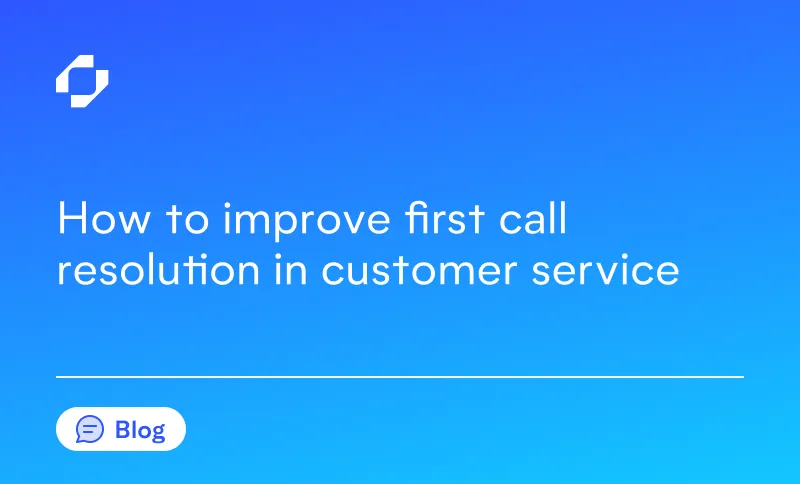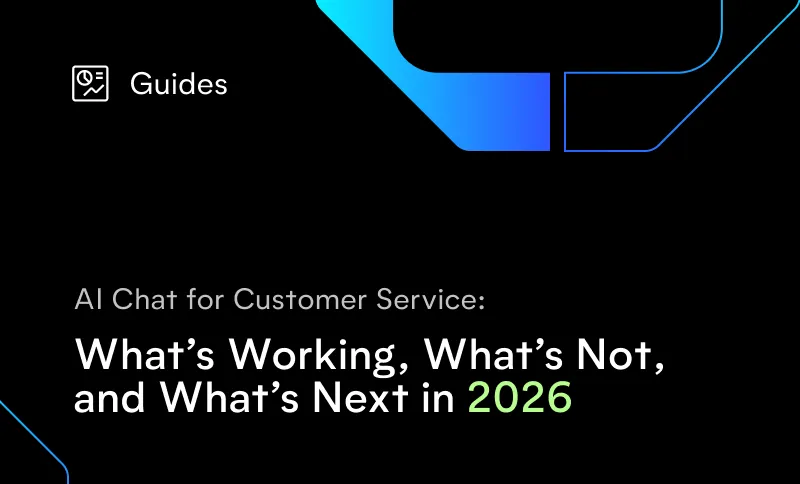
Every time a customer has to call back about the same issue, you've missed an opportunity. First call resolution (FCR) isn't just another metric on your dashboard. It's the difference between delighted customers and frustrated ones, between efficient operations and wasteful spending. Think about your own experiences as a customer: how did you feel the last time you had to explain your problem three different times to three different agents? Not great, right? That's exactly why FCR deserves your full attention.
When customers reach out with problems, they're looking for solutions, not the runaround. Each follow-up call multiplies your costs while dividing customer patience. The math isn't complicated: resolving issues in a single interaction saves money and builds loyalty. In this comprehensive guide, we'll break down exactly what FCR is, show you why it should be at the top of your priority list, walk through six practical steps to dramatically improve your resolution rates, and share battle-tested best practices that actually work in the real world of customer service. Whether you're just starting to track FCR or looking to push your already-good numbers into great territory, you'll find actionable strategies you can implement right away.
What is first call resolution in customer service?
FCR measures the percentage of customer issues that are completely resolved during the initial interaction, eliminating the need for follow-up contacts. This metric focuses specifically on resolution (not just response) meaning the customer's problem must be fully addressed and fixed during that first touchpoint. True FCR occurs when customers receive the complete solution they need without having to reach out again about the same issue.
Unlike other contact center metrics that might track efficiency or speed, FCR directly reflects effectiveness from the customer's perspective. It encompasses all communication channels including phone calls, emails, chat sessions, or social media interactions, and requires careful tracking to ensure issues don't resurface days later. Many organizations consider an issue "resolved" only if the customer doesn't return with the same problem within a defined timeframe, typically 5-7 days after the initial contact. This comprehensive measurement approach ensures FCR accurately captures true resolution rather than temporary fixes that might fail shortly after the interaction ends.
Benefits of improving first call resolution in customer service
Boosting your FCR rates delivers multiple advantages that positively impact your entire operation.
- Increases Customer Satisfaction: Customers overwhelmingly prefer having their issues resolved immediately rather than enduring multiple contacts. Higher FCR rates correlate directly with improved CSAT scores and overall customer happiness.
- Reduces Operational Costs: Repeat calls drive up expenses significantly. Each additional contact requires agent time, resources, and infrastructure—multiplying the cost of what could have been a single, efficient interaction.
- Improves Agent Efficiency: When agents successfully resolve issues on the first attempt, they can handle more unique customer inquiries rather than revisiting the same problems repeatedly, improving productivity metrics.
- Boosts Brand Loyalty: Customers who experience efficient, one-contact resolutions develop stronger loyalty and are more likely to become brand advocates rather than detractors.
- Provides Actionable Insights: Tracking FCR helps identify systemic issues within your products, services, or processes that repeatedly cause customer concerns, enabling targeted improvements.
As you can see, unlike other contact center metrics, first call resolution benefits all stakeholders: call center leadership, agents, and customers.
How to improve first call resolution in customer service in 6 steps
1. Measure and analyze first call resolution rates
Improvement begins with accurate measurement. To calculate your FCR rate, divide the number of issues resolved on first contact by the total number of first contacts, then multiply by 100 to get a percentage:
FCR = (Number of issues resolved on first contact ÷ Total number of first contacts) × 100
Implement post-call surveys asking customers directly if their issue was resolved, and complement this with internal tracking systems that monitor when customers call back about the same issue within a defined timeframe (typically 7 days).
Establishing benchmarks is crucial. Compare your FCR rates against industry standards to understand where you stand. Knowing your baseline provides a starting point for setting realistic improvement goals.
Regular First Call Resolution analysis should include:
- Tracking variations across different channels (phone, chat, email)
- Monitoring FCR fluctuations during peak times versus normal operations
- Analyzing differences between agent teams or departments
2. Identify root causes of repeat calls
Understanding why customers need to call back is essential for making meaningful improvements. Implement robust call tagging and categorization systems to identify patterns in repeat contacts.
Common root causes typically include:
- Incomplete or incorrect information provided during the first interaction
- Complex issues that require specialized knowledge
- Technical limitations preventing immediate resolution
- Process gaps that create customer confusion
- Inconsistent information across different customer touchpoints
Collecting detailed customer feedback through surveys and interviews can uncover specific pain points that metrics alone might miss. Ask targeted questions about why they needed to call back and what would have helped resolve their issue on the first attempt.
Replicant's Conversation Intelligence helps contact centers automatically identify trends across thousands of interactions without manual review. The system flags repeated issues, recognizes when similar problems affect multiple customers, and can surface specific agent coaching needs based on real conversation data. This technology enables teams to spot emerging problems before they become widespread and address the root causes systematically.
3. Empower agents with tools and training
Agents need both knowledge and authority to resolve issues effectively on the first contact. Invest in comprehensive knowledge bases that are easily searchable and regularly updated with the latest information. These resources should include:
- Common troubleshooting procedures
- Product specifications and compatibility details
- Current policies and procedures
- Answers to frequently asked questions
Implement live support tools that allow agents to get expert help during difficult interactions without transferring the customer. Options include:
- Internal chat systems for reaching subject matter experts
- Screen-sharing capabilities between agents and supervisors
- Real-time guidance systems that suggest solutions based on conversation context
Regular training must go beyond initial onboarding. Schedule ongoing sessions focused on:
- New products and services
- System updates and workflow changes
- Communication techniques for difficult situations
- Scenario-based practice for complex cases
Using Replicant's Conversation Intelligence, contact centers can create targeted coaching sessions based on actual call data. The system identifies specific skill gaps by analyzing thousands of interactions, enabling supervisors to tailor training to each agent's unique development needs rather than using generic training materials. This personalized approach improves agent proficiency precisely where it's needed most.
4. Automate repeatable use cases
Getting customers directly to resolution without any wait improves FCR rates dramatically. Identify common, predictable customer inquiries that follow consistent patterns and implement automation for these scenarios. Focus on automating use cases that:
- Occur at high volume across your contact center
- Follow predictable conversation patterns
- Require minimal exception handling
- Represent clear customer value when resolved quickly
- Currently consume significant agent time
Design clear fallback paths for when automated systems encounter scenarios they can't handle. When creating these exception handling processes, ensure they include:
- Seamless transitions to human agents when needed
- Comprehensive context transfer of the conversation history
- Clear explanation to customers about what's happening next
Replicant's Conversation Automation can handle many repetitive inquiries completely independently. The system identifies the nature of customer requests through natural language understanding and resolves straightforward issues automatically. This approach ensures human agents only receive complex cases requiring their specific expertise, improving FCR for both automated and agent-handled interactions.
5. Enhance self-service options
Self-service channels often deliver high FCR rates when designed properly. Build comprehensive resources that allow customers to solve common problems independently:
- Detailed FAQs covering the most frequent customer questions
- Video tutorials for visual learners
- Step-by-step guides for complex processes
- Interactive troubleshooting tools that adapt based on customer input
Conversational AI systems like Replicant that work across voice, chat, and SMS can also handle many issues completely or gather essential information before human contact. These systems should:
- Understand natural language queries
- Offer personalized responses based on customer history
- Provide clear paths to human assistance when needed
- Learn from interactions to continuously improve
6. Continuously monitor and refine processes
FCR improvement requires ongoing attention and refinement. Establish a regular cadence for reviewing key performance indicators, including:
- Overall FCR rate trends for AI agents and Human agents
- FCR variations by issue type, product line, or customer segment
- Correlation between FCR and other metrics like CSAT and NPS
- Cost savings generated through FCR improvements
Implement structured feedback loops that include:
- Regular agent focus groups to identify process barriers
- Customer advisory panels to provide direct input
- Cross-functional improvement teams with authority to implement changes
Schedule quarterly process reviews focused specifically on FCR, examining:
- Current bottlenecks in resolution workflows
- Technology limitations impacting first-contact solutions
- Policy constraints that prevent immediate resolution
- Knowledge gaps appearing across multiple interactions
Replicant's analytics provides continuous visibility into FCR performance for AI and Human agents and detects new automation opportunities. The system identifies patterns in customer requests that could be handled through automation, helping contact centers proactively address emerging issues before they impact resolution rates. This data-driven approach enables ongoing refinement without requiring extensive manual analysis.
Best practices for improving first call resolution
Transform your approach to FCR with these proven best practices:
- Prioritize FCR as a core performance metric, not just a secondary statistic. Feature it prominently in dashboards and make it a key component of team goals and individual performance evaluations.
- Consolidate information into unified knowledge bases accessible across all customer service channels. Ensure agents and self-service systems draw from the same consistent data sources to prevent contradictory information.
- Grant agents appropriate autonomy to resolve issues without excessive escalations. Review approval requirements that might delay resolution and empower frontline staff with reasonable decision-making authority.
- Analyze contact reasons regularly to identify and automate predictable, repeat requests. Look beyond surface-level topics to understand the underlying customer needs that drive contact volume.
- Develop clear criteria for what constitutes "resolved" across different issue types. Ensure all team members understand the difference between temporary fixes and true resolutions.
- Implement post-interaction verification processes where agents confirm resolution before ending conversations. Train teams to ask specific questions like "Have I completely resolved your issue today?" rather than vague checks.
Conclusion
Improving first call resolution delivers substantial benefits for both operational efficiency and customer satisfaction. By systematically measuring FCR, identifying root causes of repeat contacts, empowering agents with the right tools and training, implementing automation, enhancing self-service options, and continuously refining your processes, you can significantly boost this critical metric.
The most successful contact centers recognize that resolution rate improvement is an ongoing journey that requires consistent attention and cross-functional collaboration. With each incremental improvement in first-contact resolution, organizations reduce costs while simultaneously delivering the efficient, effective service experience that customers increasingly expect.
Want to see how Replicant helps teams improve first call resolution without adding headcount? Request a demo today.



.svg)



